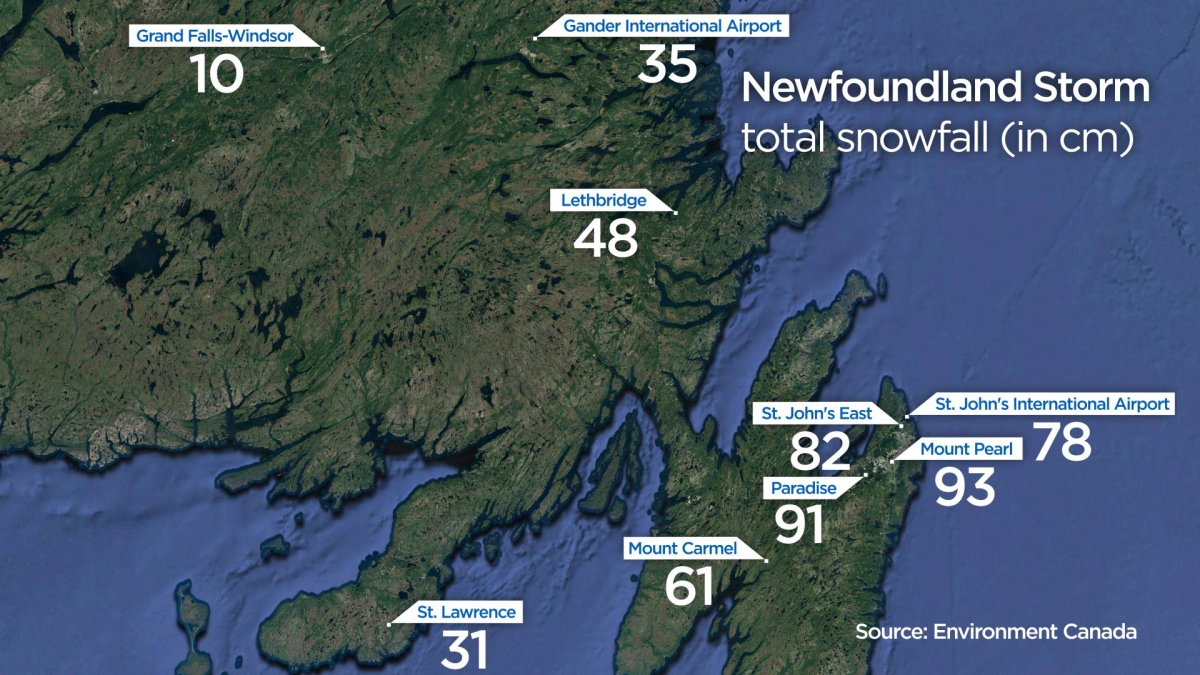Newly-released figures from Environment Canada are shedding light on the magnitude of Newfoundland‘s historic blizzard.

Many communities in the eastern part of the province have been at a near standstill since Friday when powerful winds and record-breaking snowfall prompted states of emergency.
The highest snowfall measurements were taken in areas just outside St. John’s, data from Environment Canada shows.

The city of Mount Pearl, which neighbours the capital city, received 93 centimetres of snow, while the town of Paradise received 91 cm.
At St. John’s International Airport, 76.2 cm fell. That’s the highest daily snowfall measured at the airport since at least 1942, when record-keeping began. (An additional two cm fell after 2:30 a.m., bringing the storm’s overall total to 78 cm)
The previous airport snowfall record of 68.4 cm dates back to April 5, 1999.

READ MORE: Newfoundland seeks help from Canadian Armed Forces after ‘historic’ blizzard
Towards the centre of the province, the storm was far less severe. The town of Gander received 35 cm of snow, according to a measurement taken at the airport.
In addition to the snowfall, forecasters also warned of powerful winds and storm surges.

Environment Canada says the highest wind gust of the storm was 171 km/h, measured on tiny Green Island off Fortune Bay near the French islands of Saint Pierre and Miquelon.
By comparison, sustained winds of 119 km/h and beyond are considered hurricane force.
In St. John’s, measurements taken at various locations put maximum wind gusts in the range of 105 km/h to 134 km/h.
Newfoundland and Labrador Premier Dwight Ball said the storm was “historic.”
- Roll Up To Win? Tim Hortons says $55K boat win email was ‘human error’
- Bird flu risk to humans an ‘enormous concern,’ WHO says. Here’s what to know
- Halifax homeless encampment hits double capacity, officials mull next step
- Ontario premier calls cost of gas ‘absolutely disgusting,’ raises price-gouging concerns

“It’s having a profound impact on residents,” he said in an interview with Global News on Saturday.
Given the high levels of snowfall — Ball said there were some cases of snowdrifts as high as 15 feet — the extent of the damage is not known at this point.
Photos posted to social media showed snowdrifts large enough to fully engulf cars and block doorways.
A few residents even used the steep streets of downtown St. John’s for skiing and snowboarding.
Canadian Forces members were headed to the island Sunday to provide support and help the province dig out after Ball made a request for federal assistance on Saturday.
Defence Minister Harjit Sajjan said it was likely that 150 to 200 Canadian Forces personnel would be on the ground by the end of the day.
“This could surge up to anywhere between 250 to 300 by tomorrow and the coming days,” he told reporters in Winnipeg.
St. John’s and some surrounding communities remain under states of emergency since Friday.
While all businesses were ordered to shut down and all non-emergency vehicles banned from St. John’s roads, the city is now allowing gas stations and pharmacies to open. Private plow drivers are also allowed to operate.
St. John’s International Airport has announced it remains closed for commercial flights until at least Monday night.
One man, 26-year-old Joshua Wall, has been missing since Friday in the area of Roaches Line, about 70 kilometres west of St. John’s.
–With files from the Canadian Press and Nick Logan, Global News












Comments